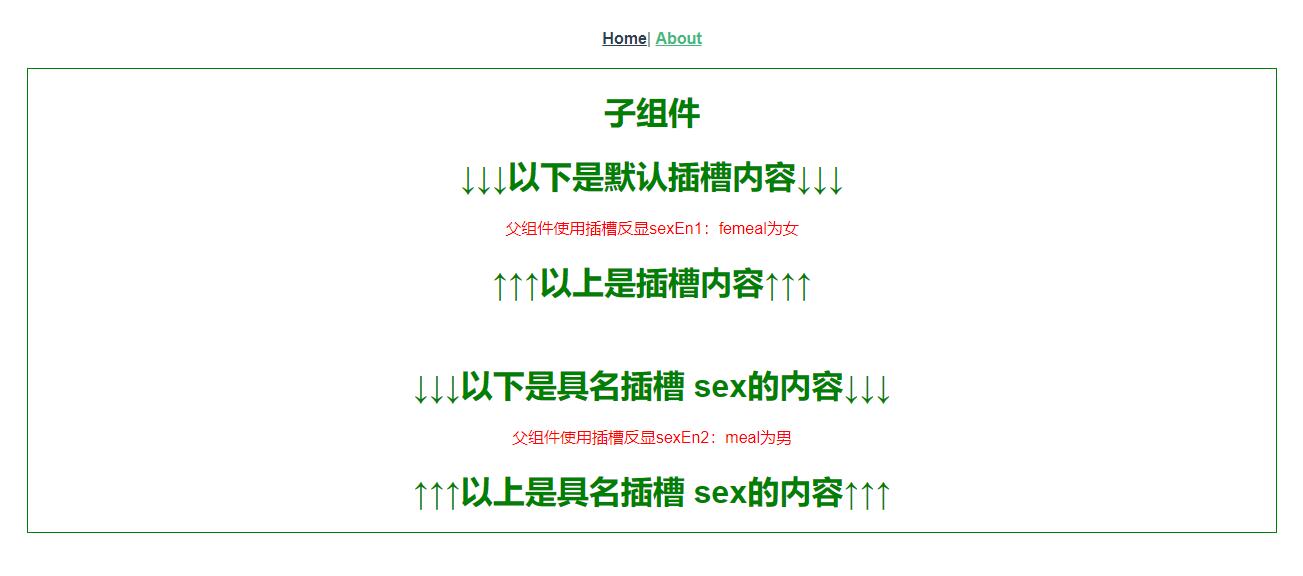vue3的新写法和特性整理——插槽的使用
Posted yjc-vue-react-java
tags:
篇首语:本文由小常识网(cha138.com)小编为大家整理,主要介绍了vue3的新写法和特性整理——插槽的使用相关的知识,希望对你有一定的参考价值。
1、子组件暴露插槽的写法
<template>
<div class="hello">
<h1>子组件</h1>
<h1>↓↓↓以下是默认插槽内容↓↓↓</h1>
<slot :scope="sexEn1"></slot>
<h1>↑↑↑以上是插槽内容↑↑↑</h1>
<br />
<div>{{sexEn}}</div>
<h1>↓↓↓以下是具名插槽 sex的内容↓↓↓</h1>
<slot name="sex" :scope="sexEn2"></slot>
<h1>↑↑↑以上是具名插槽 sex的内容↑↑↑</h1>
</div>
</template>
<script>
import { reactive, toRefs } from ‘vue‘;
export default {
setup(a,b) {
console.log(b);
const state = reactive({
sexEn1: ‘femeal‘,
sexEn2: ‘meal‘,
age: 23
});
return {
...toRefs(state)
};
},
name: ‘AgeAndSex‘
};
</script>
<style scoped>
.hello {
margin: 20px;
color: green;
border: 1px solid green;
}
.pointer {
cursor: pointer;
}
</style>
2、父组件使用插槽的写法
<template>
<div class="about">
<AgeAndSex>
<template v-slot="obj">
<div class="slot">父组件使用插槽反显sexEn1:{{obj.scope}}为{{filter(obj.scope)}}</div>
</template>
<template v-slot:sex="obj">
<div class="slot">父组件使用插槽反显sexEn2:{{obj.scope}}为{{filter(obj.scope)}}</div>
</template>
</AgeAndSex>
</div>
</template>
<script>
// eslint-disable-next-line no-unused-vars
import { reactive, toRefs } from ‘vue‘;
import AgeAndSex from ‘@/components/AgeAndSex‘;
export default {
setup() {
let filter = e => {
console.log(e);
switch (e) {
case ‘meal‘:
return ‘男‘;
case ‘femeal‘:
return ‘女‘;
default:
return ‘保密‘;
}
};
return {
filter
};
},
filters: {},
components: { AgeAndSex }
};
</script>
<style scoped>
.slot {
color: red;
}
</style>
效果图

3、顺带一提:在vue3中,已经废除了管道符(过滤器)的功能,官方提出使用计算属性的解决方案。如果复用性不高,也可以在setup中写方法,或者写在工具函数里(我个人想法是挂载到window上,然后在setup中的返回值中解构)
以上是关于vue3的新写法和特性整理——插槽的使用的主要内容,如果未能解决你的问题,请参考以下文章